Ferroelectric Switching in Trilayer Al2O3/HfZrOx/Al2O3 Structure
Abstract
:1. Introduction
2. Experiments
3. Results and Discussion
4. Conclusions
Author Contributions
Funding
Conflicts of Interest
References
- Acosta, M.; Novak, N.; Rojas, V.; Patel, S.; Vaish, R.; Koruza, J.; Rossetti, G.A.; Rödel, J. BaTiO3-based piezoelectrics: Fundamentals, current status, and perspectives. Appl. Phys. Rev. 2017, 4, 041305. [Google Scholar] [CrossRef] [Green Version]
- Müller, J.; Yurchuk, E.; Schlosser, T.; Paul, J.; Hoffmann, R.; Muller, S.; Martin, D.; Slesazeck, S.; Polakowski, P.; Sundqvist, J.; et al. Ferroelectricity in HfO2 enables nonvolatile data storage in 28 nm HKMG. In Proceedings of the 2012 Symposium on VLSI Technology, Honolulu, HI, USA, 12–14 June 2012; pp. 25–26. [Google Scholar]
- Böscke, T.S.; Müller, J.; Bräuhaus, D.; Schröder, U.; Bottger, U. Ferroelectricity in hafnium oxide: CMOS compatible ferroelectric field effect transistors. In Proceedings of the 2011 International Electron Devices Meeting, Washington, DC, USA, 5–7 December 2011; pp. 24.5.1–24.5.4. [Google Scholar] [CrossRef]
- Park, M.H.; Lee, Y.H.; Kim, H.J.; Kim, Y.J.; Moon, T.; Kim, K.D.; Müller, J.; Kersch, A.; Schroeder, U.; Mikolajick, T.; et al. Ferroelectricity and Antiferroelectricity of Doped Thin HfO2-Based Films. Adv. Mater. 2015, 27, 1811–1831. [Google Scholar] [CrossRef]
- Batra, R.; Huan, T.D.; Jones, J.L.; Rossetti, G.A.; Ramprasad, R. Factors Favoring Ferroelectricity in Hafnia: A First-Principles Computational Study. J. Phys. Chem. C 2017, 121, 4139–4145. [Google Scholar] [CrossRef]
- Dogan, M.; Gong, N.; Ma, T.-P.; Ismail-Beigi, S. Causes of ferroelectricity in HfO2-based thin films: An ab initio perspective. Phys. Chem. Chem. Phys. 2019, 21, 12150–12162. [Google Scholar] [CrossRef] [Green Version]
- Park, M.H.; Lee, Y.H.; Mikolajick, T.; Schroeder, U.; Hwang, C.S. Review and perspective on ferroelectric HfO2-based thin films for memory applications. MRS Commun. 2018, 8, 795–808. [Google Scholar] [CrossRef] [Green Version]
- Cheema, S.S.; Kwon, D.; Shanker, N.; Dos Reis, R.; Hsu, S.-L.; Xiao, J.; Zhang, H.; Wagner, R.; Datar, A.; McCarter, M.R.; et al. Enhanced ferroelectricity in ultrathin films grown directly on silicon. Nature 2020, 580, 478–482. [Google Scholar] [CrossRef] [PubMed]
- Khan, A.I.; Yeung, C.W.; Hu, C.; Salahuddin, S. Ferroelectric negative capacitance MOSFET: Capacitance tuning & antiferroelectric operation. In Proceedings of the 2011 International Electron Devices Meeting, Washington, DC, USA, 5–7 December 2011; pp. 11.3.1–11.3.4. [Google Scholar] [CrossRef]
- Polakowski, P.; Riedel, S.; Weinreich, W.; Rudolf, M.; Sundqvist, J.; Seidel, K.; Müller, J. Ferroelectric deep trench capacitors based on Al:HfO2 for 3D nonvolatile memory applications. In Proceedings of the 2014 IEEE 6th International Memory Workshop (IMW), Taipei, Taiwan, 18–21 May 2014; pp. 1–4. [Google Scholar]
- Florent, K.; Lavizzari, S.; Di Piazza, L.; Popovici, M.; Vecchio, E.; Potoms, G.; Groeseneken, G.; Van Ihoudt, J. First demonstration of vertically stacked ferroelectric Al doped HfO2 devices for NAND applications. In Proceedings of the 2017 Symposium on VLSI Technology, Kyoto, Japan, 5–8 June 2017; pp. T158–T159. [Google Scholar]
- Florent, K.; Pesic, M.; Subirats, A.; Banerjee, K.; Lavizzari, S.; Arreghini, A.; Di Piazza, L.; Potoms, G.; Sebaai, F.; McMitchell, S.R.C.; et al. Vertical Ferroelectric HfO2 FET based on 3-D NAND Architecture: Towards Dense Low-Power Memory. In Proceedings of the 2018 IEEE International Electron Devices Meeting (IEDM), San Francisco, CA, USA, 1–5 December 2018; pp. 2.5.1–2.5.4. [Google Scholar] [CrossRef]
- Jerry, M.; Chen, P.-Y.; Zhang, J.; Sharma, P.; Ni, K.; Yu, S.; Datta, S. Ferroelectric FET analog synapse for acceleration of deep neural network training. In Proceedings of the 2017 IEEE International Electron Devices Meeting (IEDM), San Francisco, CA, USA, 2–6 December 2017; pp. 6.2.1–6.2.4. [Google Scholar] [CrossRef]
- Oh, S.; Kim, T.; Kwak, M.; Song, J.; Woo, J.; Jeon, S.; Yoo, I.K.; Hwang, H. HfZrOx-Based Ferroelectric Synapse Device With 32 Levels of Conductance States for Neuromorphic Applications. IEEE Electron Device Lett. 2017, 38, 732–735. [Google Scholar] [CrossRef]
- Chernikova, A.G.; Kuzmichev, D.; Negrov, D.V.; Kozodaev, M.; Polyakov, S.N.; Markeev, A.M. Ferroelectric properties of full plasma-enhanced ALD TiN/La:HfO2/TiN stacks. Appl. Phys. Lett. 2016, 108, 242905. [Google Scholar] [CrossRef]
- Müller, J.; Schröder, U.; Böscke, T.S.; Müller, I.; Böttger, U.; Wilde, L.; Sundqvist, J.; Lemberger, M.; Kücher, P.; Mikolajick, T.; et al. Ferroelectricity in yttrium-doped hafnium oxide. J. Appl. Phys. 2011, 110, 114113. [Google Scholar] [CrossRef]
- Mueller, S.; Mueller, J.; Singh, A.; Riedel, S.; Sundqvist, J.; Schroeder, U.; Mikolajick, T. Incipient Ferroelectricity in Al-Doped HfO2 Thin Films. Adv. Funct. Mater. 2012, 22, 2412–2417. [Google Scholar] [CrossRef]
- Park, M.H.; Schenk, T.; Fancher, C.M.; Grimley, E.D.; Zhou, C.; Richter, C.; Lebeau, J.M.; Jones, J.L.; Mikolajick, T.; Schroeder, U. A comprehensive study on the structural evolution of HfO2 thin films doped with various dopants. J. Mater. Chem. C 2017, 5, 4677–4690. [Google Scholar] [CrossRef]
- Schroeder, U.; Hwang, C.S.; Funakubo, H. Ferroelectricity in Doped Hafnium Oxide: Materials, Properties and Devices; Elsevier: Amsterdam, The Netherlands, 2019. [Google Scholar] [CrossRef]
- Müller, J.; Polakowski, P.; Mueller, S.; Mikolajick, T. Ferroelectric Hafnium Oxide Based Materials and Devices: Assessment of Current Status and Future Prospects. ECS J. Solid State Sci. Technol. 2015, 4, N30–N35. [Google Scholar] [CrossRef]
- Mittmann, T.; Materano, M.; Lomenzo, P.D.; Park, M.H.; Stolichnov, I.; Cavalieri, M.; Zhou, C.; Chung, C.; Jones, J.L.; Szyjka, T.; et al. Origin of Ferroelectric Phase in Undoped HfO2 Films Deposited by Sputtering. Adv. Mater. Interfaces 2019, 6. [Google Scholar] [CrossRef] [Green Version]
- Pesic, M.; Fengler, F.P.G.; Slesazeck, S.; Schroeder, U.; Mikolajick, T.; Larcher, L.; Padovani, A. Root cause of degradation in novel HfO2-based ferroelectric memories. In Proceedings of the 2016 IEEE International Reliability Physics Symposium (IRPS), Pasadena, CA, USA, 17–21 April 2016. [Google Scholar] [CrossRef]
- Pesic, M.; Fengler, F.P.G.; Larcher, L.; Padovani, A.; Schenk, T.; Grimley, E.D.; Sang, X.; Lebeau, J.M.; Slesazeck, S.; Schroeder, U.; et al. Physical Mechanisms behind the Field-Cycling Behavior of HfO2-Based Ferroelectric Capacitors. Adv. Funct. Mater. 2016, 26, 4601–4612. [Google Scholar] [CrossRef]
- Sang, X.; Grimley, E.D.; Schenk, T.; Schroeder, U.; Lebeau, J.M. On the structural origins of ferroelectricity in HfO2 thin films. Appl. Phys. Lett. 2015, 106, 162905. [Google Scholar] [CrossRef]
- Luo, Q.; Ma, H.; Su, H.; Xue, K.-H.; Cao, R.; Gao, Z.; Yu, J.; Gong, T.; Xu, X.; Yin, J.; et al. Composition-Dependent Ferroelectric Properties in Sputtered HfXZr1−XO2 Thin Films. IEEE Electron Device Lett. 2019, 40, 570–573. [Google Scholar] [CrossRef]
- Min, D.-H.; Kang, S.Y.; Moon, S.E.; Yoon, S.-M. Impact of Thickness Control of Hf0.5Zr0.5O2 Films for the Metal–Ferroelectric–Insulator–Semiconductor Capacitors. IEEE Electron Device Lett. 2019, 40, 1032–1035. [Google Scholar] [CrossRef]
- Woo, J.; Goh, Y.; Im, S.; Hwang, J.H.; Kim, Y.; Kim, J.H.; Im, J.-P.; Yoon, S.-M.; Moon, S.E.; Jeon, S. Improved Ferroelectric Switching in Sputtered HfZrOx Device Enabled by High Pressure Annealing. IEEE Electron Device Lett. 2020, 41, 232–235. [Google Scholar] [CrossRef]
- Goh, Y.; Jeon, S. Enhanced tunneling electroresistance effects in HfZrO-based ferroelectric tunnel junctions by high-pressure nitrogen annealing. Appl. Phys. Lett. 2018, 113, 052905. [Google Scholar] [CrossRef]
- Kim, T.; Jeon, S. Pulse Switching Study on the HfZrO Ferroelectric Films With High Pressure Annealing. IEEE Trans. Electron Devices 2018, 65, 1771–1773. [Google Scholar] [CrossRef]
- Cheng, C.-H.; Chin, A. Low-Voltage Steep Turn-On pMOSFET Using Ferroelectric High-k Gate Dielectric. IEEE Electron Device Lett. 2014, 35, 274–276. [Google Scholar] [CrossRef]
- Kim, Y.; Woo, J.; Im, S.; Lee, Y.; Kim, J.H.; Im, J.-P.; Suh, D.; Yang, S.M.; Yoon, S.-M.; Moon, S.E. Optimized annealing conditions to enhance stability of polarization in sputtered HfZrOx layers for non-volatile memory applications. Curr. Appl. Phys. 2020. accepted. [Google Scholar]
- Müller, J.; Boscke, T.S.; Schröder, U.; Mueller, S.; Bräuhaus, D.; Böttger, U.; Frey, L.; Mikolajick, T. Ferroelectricity in Simple Binary ZrO2 and HfO2. Nano Lett. 2012, 12, 4318–4323. [Google Scholar] [CrossRef] [PubMed]
- Stengel, M.; Spaldin, N.A. Origin of the dielectric dead layer in nanoscale capacitors. Nature 2006, 443, 679–682. [Google Scholar] [CrossRef] [PubMed]
- Si, M.; Lyu, X.; Ye, P.D. Ferroelectric Polarization Switching of Hafnium Zirconium Oxide in a Ferroelectric/Dielectric Stack. ACS Appl. Electron. Mater. 2019, 1, 745–751. [Google Scholar] [CrossRef] [Green Version]
- Ryu, H.; Wu, H.; Rao, F.; Zhu, W. Ferroelectric Tunneling Junctions Based on Aluminum Oxide/ Zirconium-Doped Hafnium Oxide for Neuromorphic Computing. Sci. Rep. 2019, 9, 20383. [Google Scholar] [CrossRef] [Green Version]
- Onaya, T.; Nabatame, T.; Sawamoto, N.; Ohi, A.; Ikeda, N.; Chikyow, T.; Ogura, A. Improvement in ferroelectricity of HfxZr1−xO2 thin films using ZrO2 seed layer. Appl. Phys. Express 2017, 10, 81501. [Google Scholar] [CrossRef]
- Xiao, W.; Liu, C.; Peng, Y.; Zheng, S.; Feng, Q.; Zhang, C.; Zhang, J.; Hao, Y.; Liao, M.; Zhou, Y.; et al. Performance Improvement of Hf0.5Zr0.5O2-Based Ferroelectric-Field-Effect Transistors With ZrO2 Seed Layers. IEEE Electron Device Lett. 2019, 40, 714–717. [Google Scholar] [CrossRef]
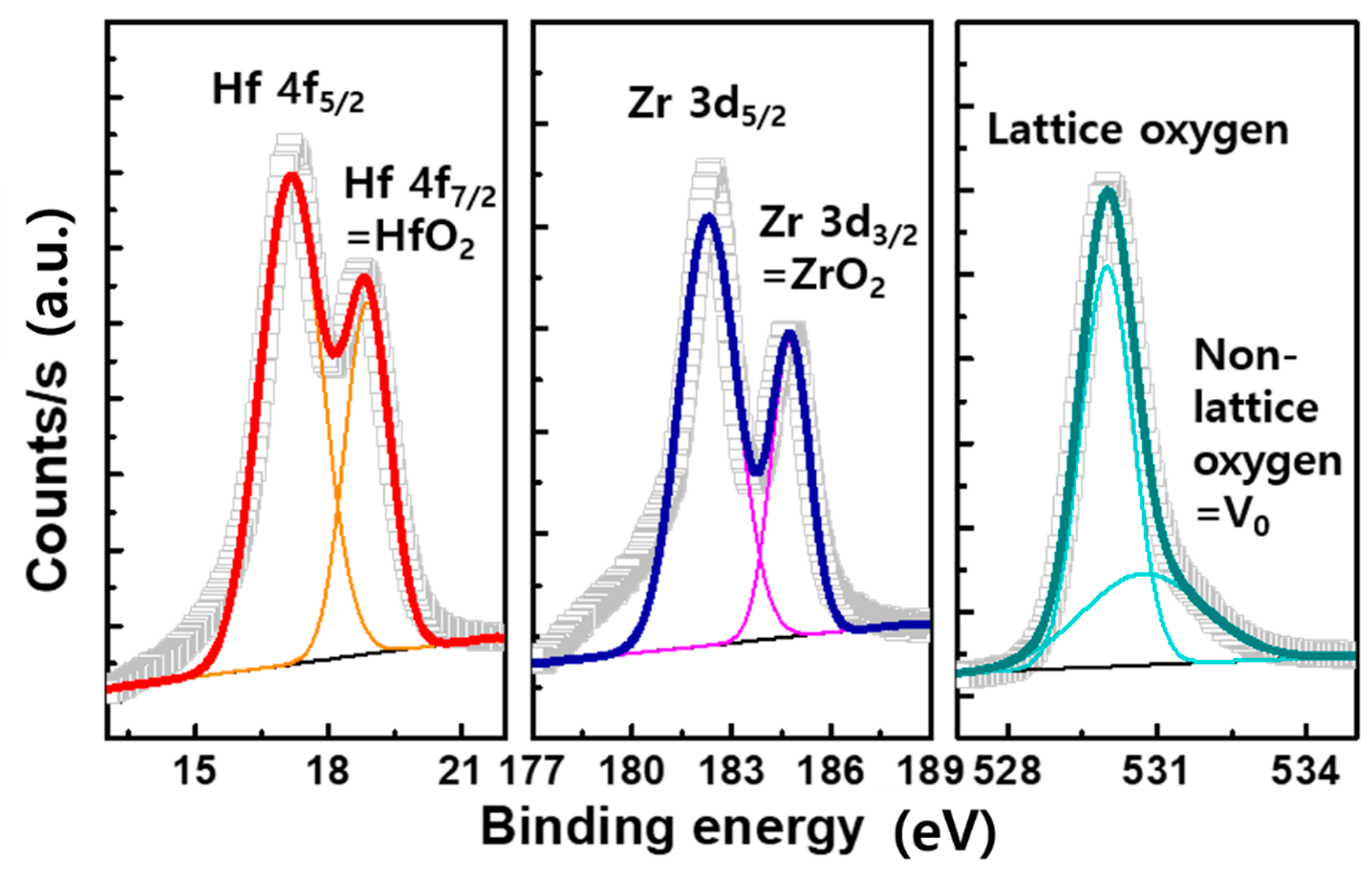
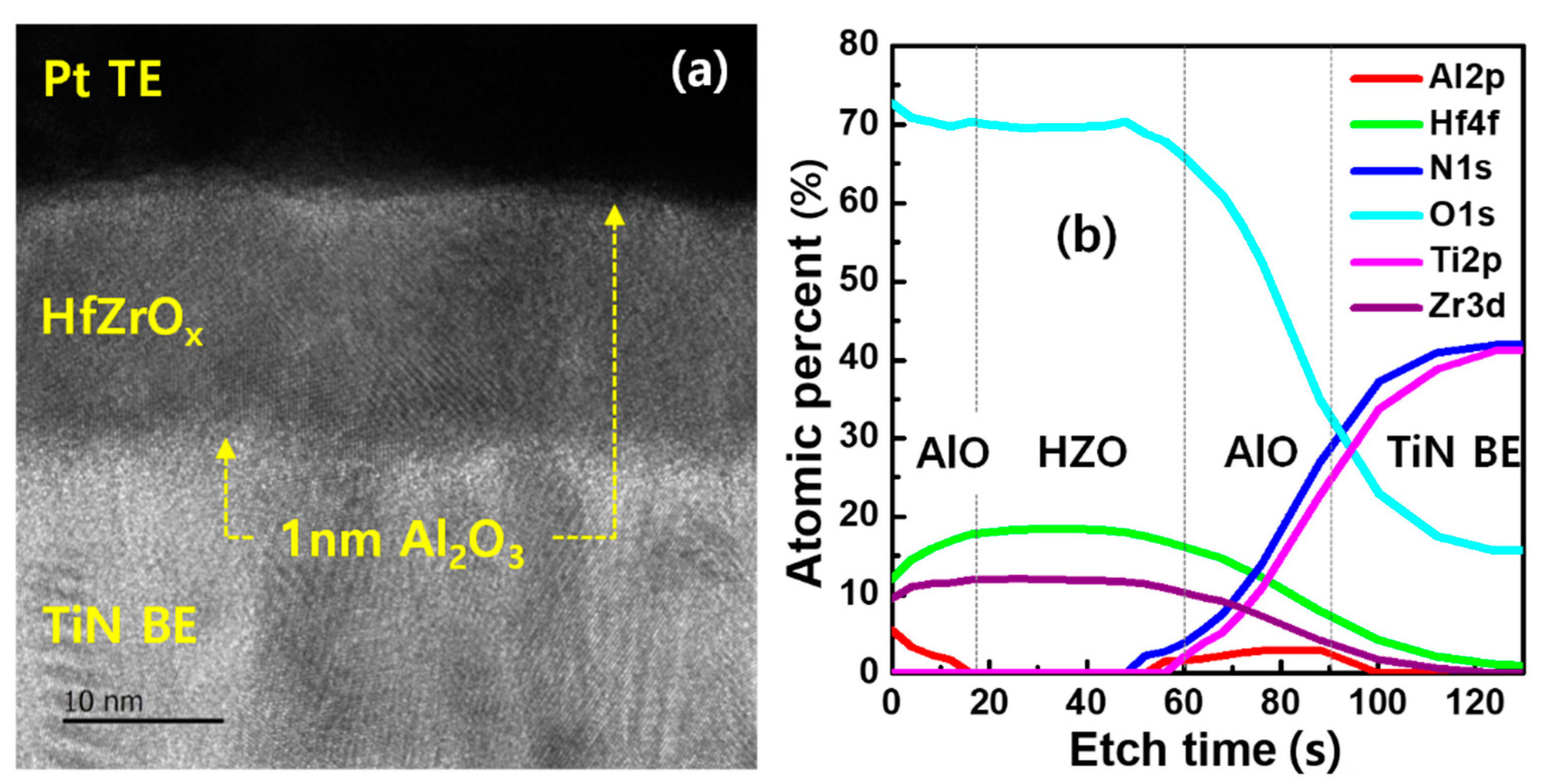
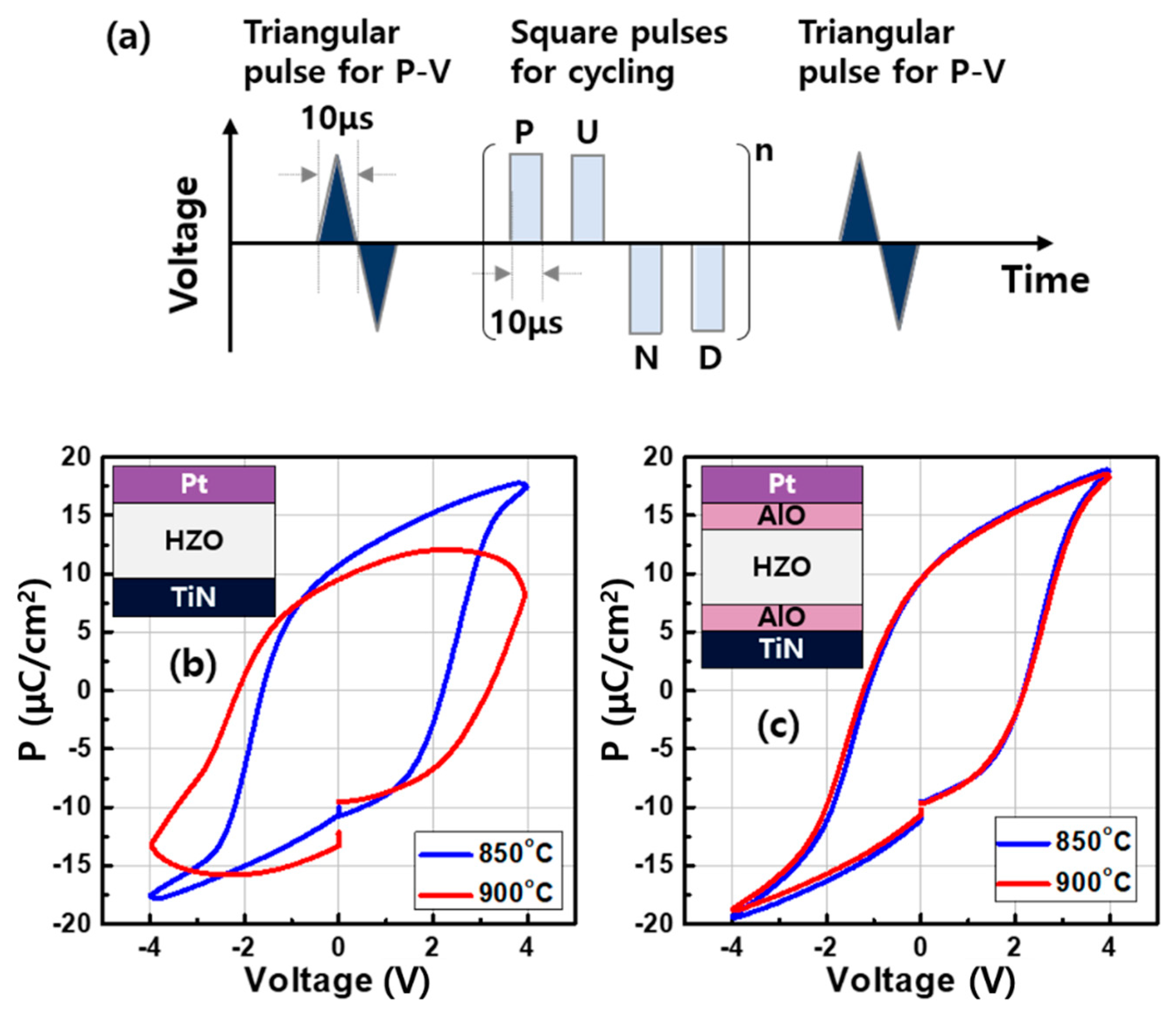
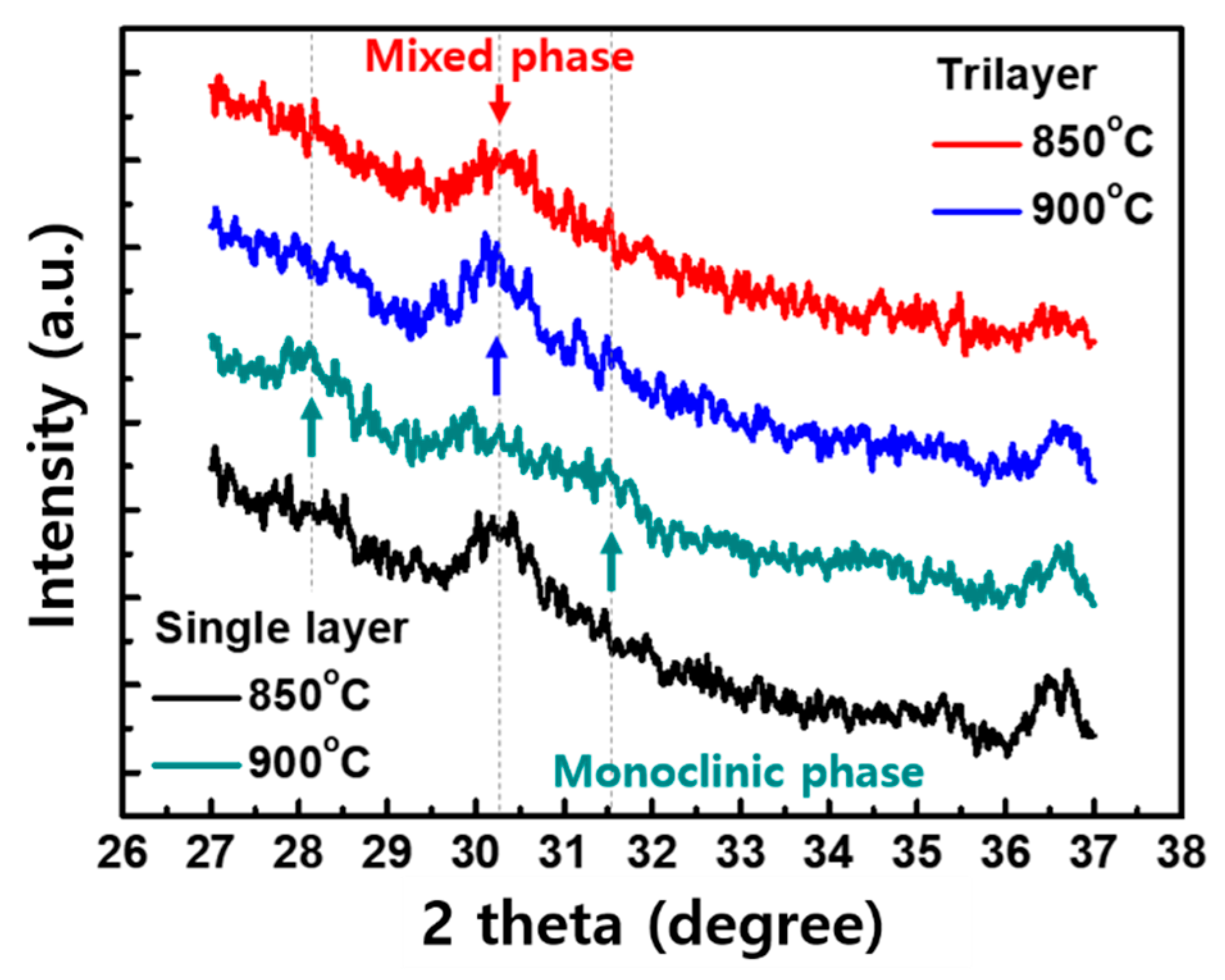

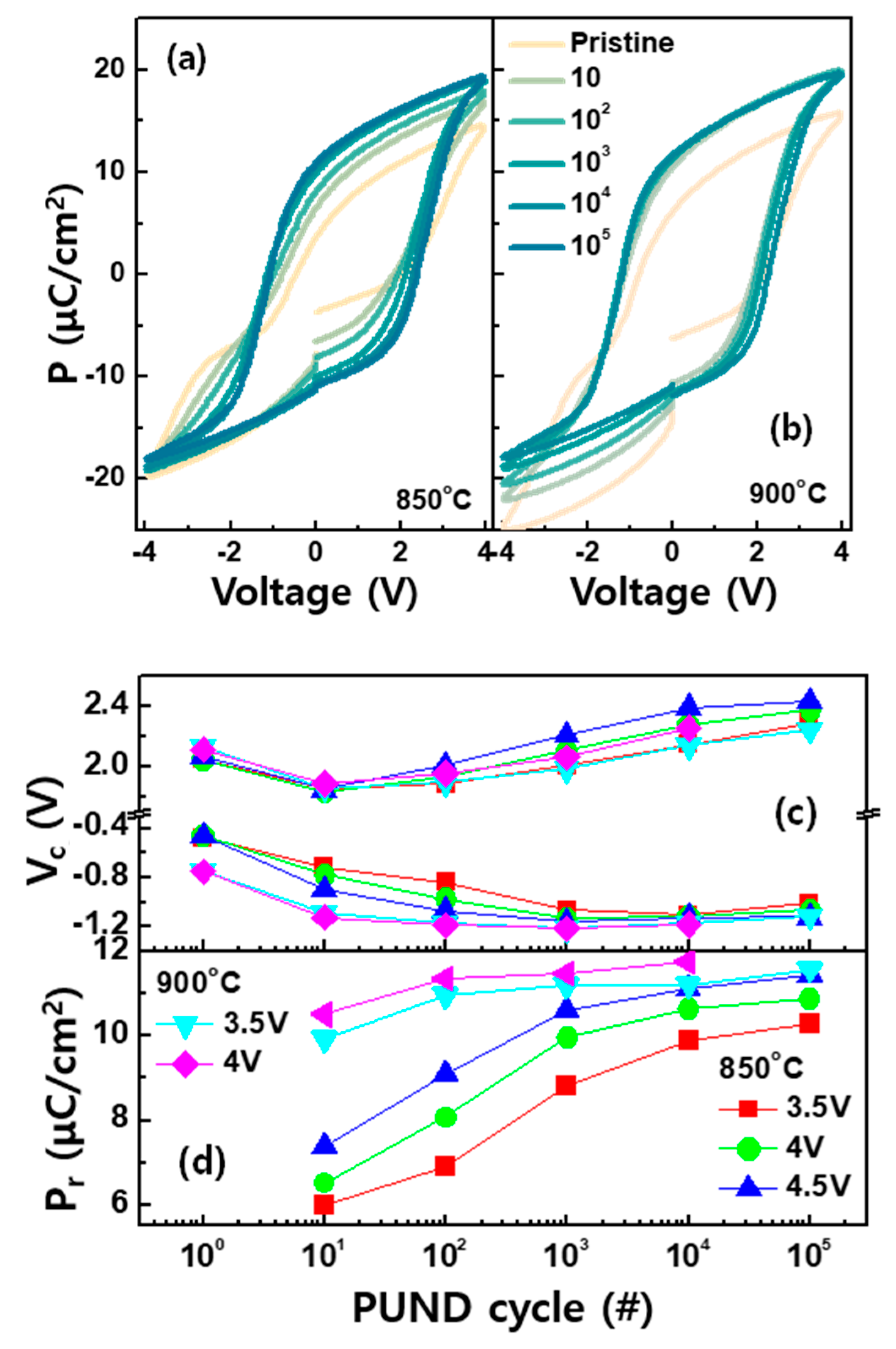
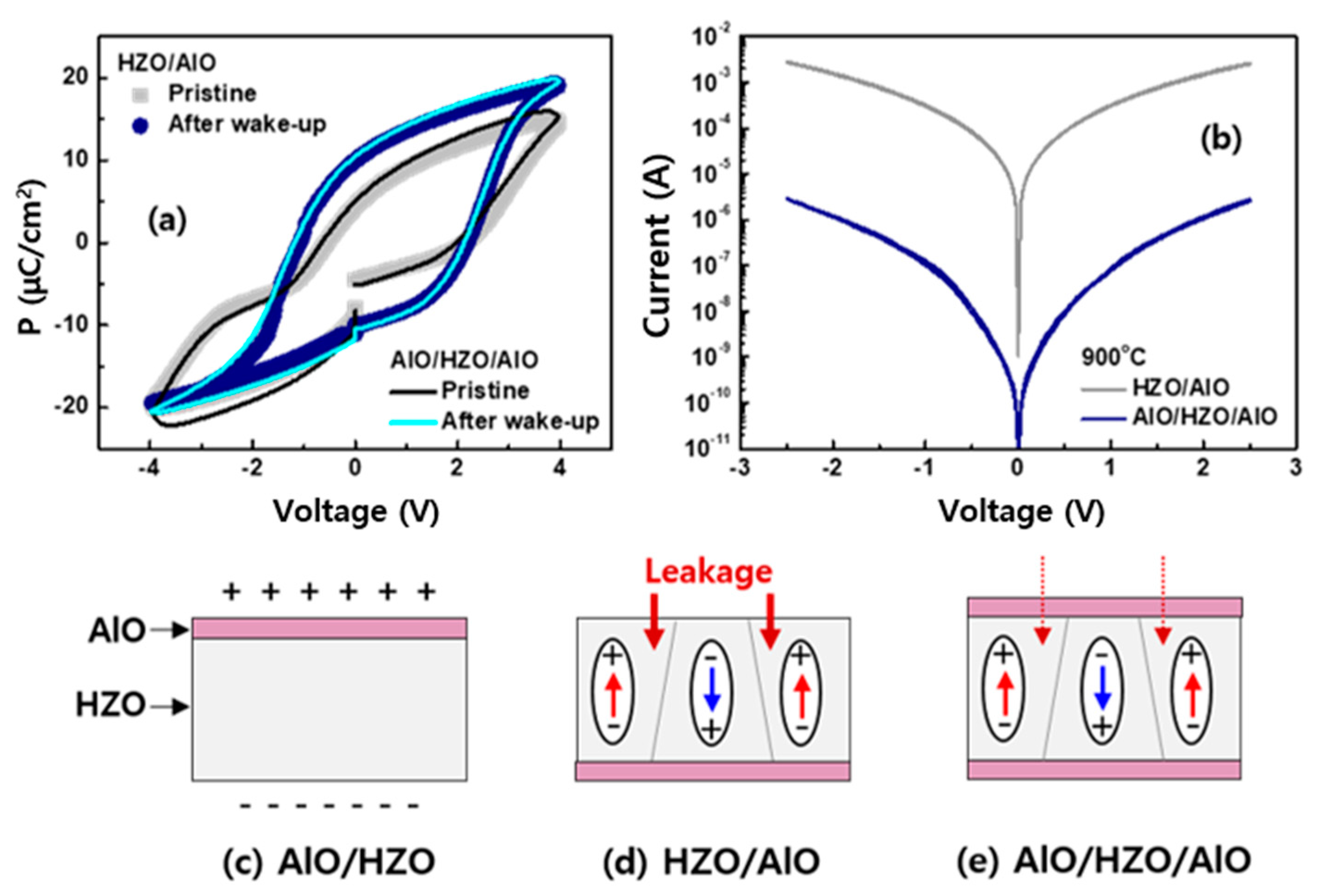
© 2020 by the authors. Licensee MDPI, Basel, Switzerland. This article is an open access article distributed under the terms and conditions of the Creative Commons Attribution (CC BY) license (http://creativecommons.org/licenses/by/4.0/).
Share and Cite
Im, S.; Kang, S.-Y.; Kim, Y.; Kim, J.H.; Im, J.-P.; Yoon, S.-M.; Moon, S.E.; Woo, J. Ferroelectric Switching in Trilayer Al2O3/HfZrOx/Al2O3 Structure. Micromachines 2020, 11, 910. https://doi.org/10.3390/mi11100910
Im S, Kang S-Y, Kim Y, Kim JH, Im J-P, Yoon S-M, Moon SE, Woo J. Ferroelectric Switching in Trilayer Al2O3/HfZrOx/Al2O3 Structure. Micromachines. 2020; 11(10):910. https://doi.org/10.3390/mi11100910
Chicago/Turabian StyleIm, Solyee, Seung-Youl Kang, Yeriaron Kim, Jeong Hun Kim, Jong-Pil Im, Sung-Min Yoon, Seung Eon Moon, and Jiyong Woo. 2020. "Ferroelectric Switching in Trilayer Al2O3/HfZrOx/Al2O3 Structure" Micromachines 11, no. 10: 910. https://doi.org/10.3390/mi11100910
APA StyleIm, S., Kang, S.-Y., Kim, Y., Kim, J. H., Im, J.-P., Yoon, S.-M., Moon, S. E., & Woo, J. (2020). Ferroelectric Switching in Trilayer Al2O3/HfZrOx/Al2O3 Structure. Micromachines, 11(10), 910. https://doi.org/10.3390/mi11100910



